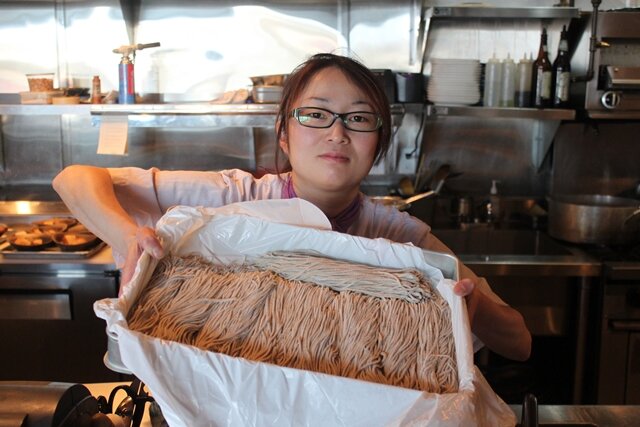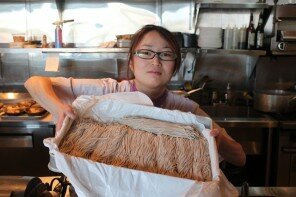Gomen na. That’s Japanese for “I’m sorry,” and something I want to state from the outset. I really hate to be a wet noodle about our ramen boom, but as someone who’s spent considerable time in Japan, I’ve been feeling a little sad about the state of ramen in Seattle.
During one of my 12 trips to Japan, I remember being glued to the TV watching a show dedicated to ramen. In it, three experts traveled restaurant to restaurant judging ramen quality. When deeming a bowl bad, an expert would bow his head, solemnly say “Gomen na,” and simply walk out of the place.
I can’t tell you how many times I’ve wanted to do the same here.
I’m seeing so many chefs falling in love with ramen (understandably so!) and making it themselves—putting their own spins on it. When I try their creations, I’m confused. Something about the noodles, the soup, and the toppings is just not right.
As a result, I worry that ramen will lose its authenticity. People will soon think of it as misguidedly as many think of sushi: rolls that would be foreign in Japan. No native Japanese chef would sandwich cream cheese and hot pepper jelly into rice and call it sushi. Similarly, you won’t find ramen made with sous vide short ribs and candied carrots in the Land of the Rising Sun. But, all too often, that’s the direction the dish is taking in the United States.
So I’m calling for a change in nomenclature. Just as I don’t think we should call sushi rolls “sushi,” I think we need another name for Westernized ramen. Here’s my proposal. If you’re trying to make authentic Japanese ramen, continue to call it by its original name: ramen. But if you’re not trying to be authentic, then let’s call your creation something new: Wramen. Pronounced double-u ramen, it indicates a version that you wouldn’t expect to see in Japan.
Authentic ramen transports me to Tokyo (or Hakata, or Hokkaido), whereas if you’re using parmesan cheese, fried chicken or oysters, apple slices, smoked kielbasa, or tofu, that’s Wramen. The same is true for foie gras, duck confit, duck fat, and duck anything. (Do American chefs depend on duck fat to get depth of flavor that they can’t seem to extract from pork/chicken bones and seafood?) Fancy ingredients take me far from Japan, often at fanciful pricing. At the same time, trying to make ramen too healthy renders a result of Wramen. While the Japanese love to eat seasonally, there’s no call for seasonal vegetables in ramen. And don’t get me started on vegetarian ramen. It’s a rarity in Japan. In fact, there’s little concern about fat/oil content and MSG in ramen—they’re an integral (and flavorful) part of the package.
The new name Wramen not only maintains the integrity of authentic ramen, it allows me to critique both types accordingly. And to just plain try to enjoy both of them. After all, some of the Wramen I’ve eaten has been daring and delicious. Then again, some Wramen has been a completely wreck.
Examples of the Wramen scene in Seattle:
- Brimmer & Heeltap: The noodles in the “family meal ramen” are too spongy soft, but the flavors of the Chinese-style pork and the kimchi Brussels sprouts make this a delicious Wramen.
- TanakaSan: The ever-changing ingredient combinations are intriguing (#3 includes smoked kielbasa and Savoy cabbage), though the use of soba-like whole wheat noodles is strange.
- Mighty Ramen: The chef says he’s “going more for delicious than authentic,” using fresh, local ingredients, but this translates to weak soup, pork that’s too lean, and a high price for a small bowl. (An A for effort attempting handmade noodles, but they’re too chewy.)
- Bloom: Fresh corn has shown the striving for seasonality, but was misplaced in the Showa tonkotsu ramen and the chicken shio ramen—with both soups weak and surprisingly indistinguishable from each other.
- (Further afield, I’ve enjoyed ramen with pulled pork, fried chicken, and pickled mustard seeds in aioli at Boke Bowl in Portland, as well as a beef brisket and mirin-glazed bacon with mixed greens ramen at Burdock & Co. in Vancouver, BC. Both clearly Wramen, and both really good!)
Perhaps the best illustration of the Wramen trend comes from Boom Noodle. Jonathan Hunt visited Japan to immerse himself in the country’s cuisine upon getting the executive chef job at Boom, even apprenticing for a day under Ivan Orkin of Ivan Ramen fame. His ramen got to be quite good. But new management mandated an end to use of MSG, among other changes. Hunt eventually left and the ramen has since spiraled downward in quality, with the Tokyo (shoyu) ramen now resembling mushroom soup. It’s no wonder Boom is going bust as its restaurants close one by one.
In contrast to all the new Wramen, I’d like to see Seattle get a “real” ramen restaurant that scores three perfect 10s: 10 seats, 10-minute eating time, and a cap of $10 per bowl. Serve just ramen—specializing in only one or two types—and perhaps gyoza on the side. No cocktails, no big menu, no Western spins.
Redefining ramen in America will require educating diners and chefs alike. Just as the ramen master in Tampopo (a must -see “ramen Western” centered on a ramen shop) taught his disciple to have reverence for the bowl (“appreciate its gestalt” and “caress the surface with the chopstick tips…to express affection”), chefs should have reverence for ramen, too. They can start by identifying their bowls as authentic—or as Wramen. As a writer, I’ll be doing that, and invite others to do the same.
Where to Try Really Good “Real” Ramen in the Seattle Area
- Tsukushinbo: Home-style shoyu ramen served lunch-only on Fridays that cheap and good.
- 4649 Yoroshiku: Miso is best at this Sapporo-style restaurant that’s upped its focus on ramen for lunch
- Kukai: Yuzu-shio shines (others are okay) at this Bellevue restaurant reportedly expanding to Northgate and South Lake Union.
- Jinya: Decent tonkotsu (I’ve had it in Vancouver) due to arrive next week at Crossroads Mall.
- Santouka: Schedule to open in April in Bellevue, the specialty is tonkotsu, and it’s likely to be the best ramen in the Seattle area (again, I’ve had it in Vancouver).
- Biwa: If you’re headed to Portland, Biwa bests all of Seattle’s current ramen shops.
- G-men: This Richmond, BC restaurant serves my favorite ramen in the Pacific Northwest, truly transporting me to Japan (also good in Vancouver: Motomachi Shokudo).
Rules for Ramen (aka Why Ramen Might Not Succeed in Seattle, or Why the Lines at Ippudo in NYC Drive Me Crazy)
- Don’t order a cocktail, don’t go to the bathroom just before your ramen comes to the table, don’t dawdle once it arrives, and don’t let it cool off. Eat your ramen quickly so the soup is hot and the noodles don’t get soft.
- Don’t mix all the toppings. Pick at them intermittently, enjoying the various components. This is interactive eating.
- Don’t try to be politely quiet. Slurp, pulling in soup with the noodles, along with air to cool things off.
- Don’t complain about saltiness or fattiness. Ramen isn’t intended to be healthy food. Oil glistening on the surface of the soup is a good thing.
- Don’t wear your Sunday best when eating ramen. Expect oil stains, especially if you drink your soup from the bowl once you finish your noodles and toppings.
- Don’t linger. Leave when you finish so someone else can sit. Go get coffee or a cocktail elsewhere if you want to chat with your companion(s).
Note: As for some of the more notable, heretofore unmentioneds: Setsuna is pretty good but needs hotter soup and a little more depth of flavor. Samurai Noodle has disappointed of late with somewhat weak soup. Aloha Ramen offers a wide variety of bowls, but never quite wows me. (Their shio is my favorite of the shop.) Ramen Man comes closest to my vision of an ideal ramen shop setting, but the tori-paitan is too light for my taste, the chashu is too lean and cold, and the hard-boiled eggs don’t do much more than distract me.
More photos:

